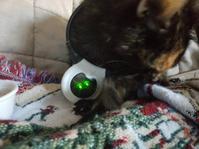Meredith Wille, LVT, CCRP

Meredith Wille, LVT, CCRP, is passionate about many things in veterinary care, including emergency medicine and exotics, but her main focus is in rehabilitation and pain management. She also particularly loves pharaoh hounds but has opened her house to many breeds, including a rare pumi. She works her magic at Pets in Harmony in Harmony, Pennsylvania, as well as Allegheney North Veterinary Hospital in Pittsburgh.
It sure seems like one of her very favorite modalities is the Assisi Loop; “It is hard for people to really believe that this weird-looking little device is so beneficial. I mean, I was very skeptical when I first saw it,” she says. “And the truth is that if it wasn’t part of my CCRP course, I’m not sure I would have believed it. But now, I know it’s a remarkable little thing.” We chatted with her about her favorite cases and applications.
AAH: (Before we could even ask a question, Meredith told us how she feels!)
Meredith Wille: I absolutely love the Assisi Loop. Love it. I can’t really  say enough good things about the device, because I love it so much. We were in Tennessee for the International Association for Veterinary Rehabilitation and Physical Therapy’s International Symposium and Rehab Summit in summer 2018, and I kept stopping at the Assisi booth and saying hi. At one point I came back, the Assisi folks asked, ‘What are you telling people? And I said, ‘What do you mean?’ And they said, ‘We are selling out, and everyone has said you told them to come by.’ I just told them I like it.
say enough good things about the device, because I love it so much. We were in Tennessee for the International Association for Veterinary Rehabilitation and Physical Therapy’s International Symposium and Rehab Summit in summer 2018, and I kept stopping at the Assisi booth and saying hi. At one point I came back, the Assisi folks asked, ‘What are you telling people? And I said, ‘What do you mean?’ And they said, ‘We are selling out, and everyone has said you told them to come by.’ I just told them I like it.
AAH: What are some of the coolest cases you’ve had?
I think the most unique use of it that I’ve done so far was a 15 year old cat. Maggie presented to the veterinarian for disorientation, weakness in the forelimbs, and inappetance. It was an overall general decline. She likely had an intracranial lesion; that was the vet’s best guess. Since she was 15 years old, they opted not to do an MRI. I think they tried steroids for a little while, which helped a tiny little bit; but then she was maxed out on her steroid dose for her weight, and there still wasn’t much of a significant improvement.
I said I wouldn’t laser because we don’t know what’s wrong, and I just find that too risky. So I said, why don’t we try the Assisi loop? Because if you suspect that it’s intracranial disease, then obviously it’s inflammation, and the Loop helps.
 I called the owner, I explained the therapy to her, and that you do it at home with Maggie. You don’t have to take her anywhere. And the owner was over-the-moon ecstatic about it. She bought the 10-centimeter Loop and I told her just to put it over Maggie’s head and let her wear it like a little collar for the treatments. She did it three times a day.
I called the owner, I explained the therapy to her, and that you do it at home with Maggie. You don’t have to take her anywhere. And the owner was over-the-moon ecstatic about it. She bought the 10-centimeter Loop and I told her just to put it over Maggie’s head and let her wear it like a little collar for the treatments. She did it three times a day.
And after two or three days, the owner texted me and she said, ‘I don’t really know what this thing does. But I have to be honest; I thought you sold me a pipe dream to make me feel better.’ And this is a cat who, for a couple months, wasn’t eating well. They were hand-feeding her. She couldn’t get up and down stairs.
And after about three days of three times a day, they went out to dinner and they kept the cat locked upstairs with a baby gate. When they came home, not only had Maggie climbed up over the baby gate and come down the stairs, she ate an entire bowl of food and was laying on the couch in the living room, and she jumped off the couch and came over to greet them.
We continued on three times a day, for about three or four weeks. She really turned a corner once we added the Assisi Loop. We tried going down to twice a day, and after about one or two days, the owner texted me and she said her symptoms are returning. So we went back to three times a day.
In the mornings, Maggie would come downstairs for breakfast. Her owner would get the Loop out and she would put it on her, turn it on and let the treatment run. And then when it was finished, she would go to take it off, and Maggie would put her little paws up and hold on to the battery pack.
AAH: Was there one moment in particular where it really hit you that it worked?
It was with my own personal dog. In August of 2017, my 13-year-old pharaoh hound, Kinneson, had chronic neck pain. I had managed him for several years on nonsteroidals and gabapentin, and he had done fine. But in August of that year, he got really gastrointestinally sick and was hospitalized on fluids, and I had to take him off of all of his medications. I knew exactly what was going to happen; in a matter of days he was going to be walking in a U shape. If anybody came close to him, he would scream bloody murder. But I had no choice.
 I thought, ‘Well, what do I have to lose? I’m just gonna try the Loop because I don’t know what else to do for him.’ I took a Loop home and I did it twice a day, and, long story short, after I started using the Loop with him, I never had to put him back on his medications. It was amazing.
I thought, ‘Well, what do I have to lose? I’m just gonna try the Loop because I don’t know what else to do for him.’ I took a Loop home and I did it twice a day, and, long story short, after I started using the Loop with him, I never had to put him back on his medications. It was amazing.
That is what completely sold me on the device. I knew the device clearly controlled his pain and inflammation completely. I lost him in November 2017; he had congestive heart failure and a prostatic mass. But he lived completely pain-free up until the rest of the health complications took over. But he really is what completely sold me on the device, and there have been plenty of others since then.
AAH: Tell us about the plenty of others!
I also used it on a 9- or 10-year-old golden retriever, Layla, who was getting chemotherapy for lymphoma, and one of her doses of chemo went outside the vein. It was destroying and sloughing the tissue in her back leg. There’s absolutely no way to sugarcoat what happens when chemo goes outside of the vein; it’s awful
An oncologist looked at the wound and said, ‘I’m really sorry, but there’s a possibility that she’ll have to have the leg amputated because the tissue will get necrotic.’ Obviously, the owners were really upset. This was at our sister clinic, so I knew about the case, and I said, ‘I would certainly use the Assisi Loop over that.’ And the doctor chose not to do it.
So this dog had bandage, after bandage, after bandage, after bandage, and this leg was pretty gross seeping for about a month; the tissue was turning black. I kept saying, ‘We just should use the Assisi Loop. I’m telling you, if you use an Assisi Loop over this wound, it is going to heal up in record time.’ And they didn’t want to do it. Everybody had resigned to the fact that the dog was going to lose the leg, and I said, ‘If we use the Assisi Loop, she’s not going to lose any portion of this leg, period. It looks fine.’
And they said, ‘Meredith, it’s black.’ I said, ‘I understand that. But I’m telling you, I have confidence in this device. And it’s going to heal that.
Sure enough, so they took the Loop home. And two weeks later, the owner texted me a picture of the leg—completely pink healthy tissue. And then four weeks, completely healed. Did not lose one bit of tissue.
AAH: Wow! That’s pretty amazing.
I do think we waited too long to start to treatments; had we started it immediately, I think the dog would have complete use of the leg, but because of the way that the skin healed it is a little tight, so she has a slight decrease in the movement. But she went from potentially losing the entire leg to that.
AAH: Those are some pretty convincing cases.
Yeah, those are probably like the three most dramatic responses in cases that I’ve had. For more everyday use, chronic osteoarthritis cases are the ones that I recommended the most. There’s the ease of the owners able to use it at home, but sometimes we have to weigh the cost of it; if I had my way, it would be with every post-op orthopedic case. But unfortunately, not everybody can afford it.
AAH: Do you have a go-to phrase or argument or discussion for folks who aren’t really sure what to think of the Loop?
 There are two things that I commonly tell people. One is the information from the human research in the post-op mastectomies, because I think most people can relate to that type of a scenario. I also tell them about my own dog, so people know that I’ve used it and that I’ve seen success in my own personal dog. I can’t say enough good things about the device.
There are two things that I commonly tell people. One is the information from the human research in the post-op mastectomies, because I think most people can relate to that type of a scenario. I also tell them about my own dog, so people know that I’ve used it and that I’ve seen success in my own personal dog. I can’t say enough good things about the device.
